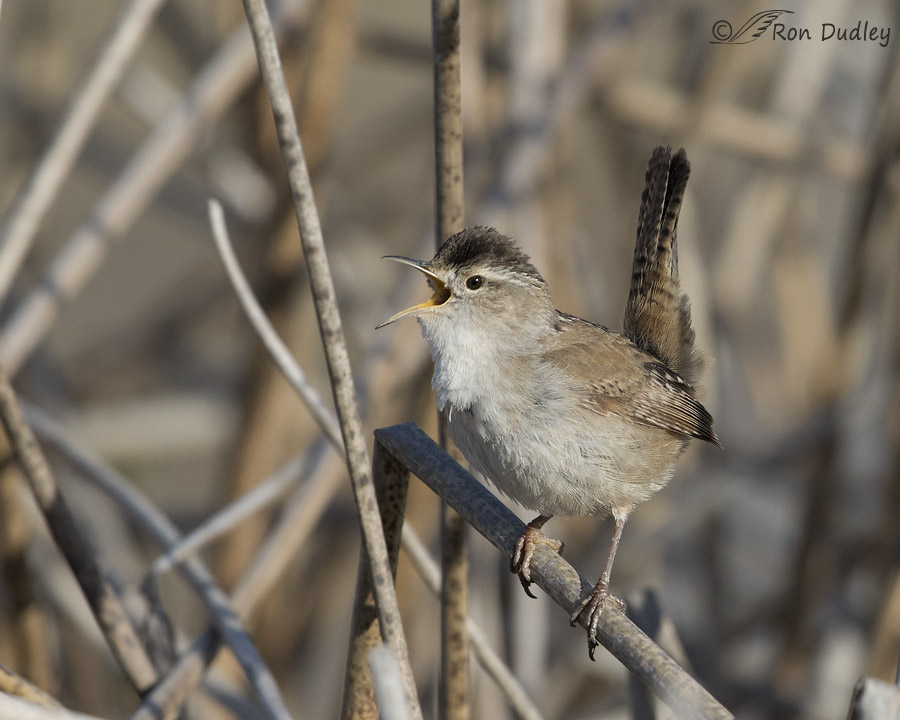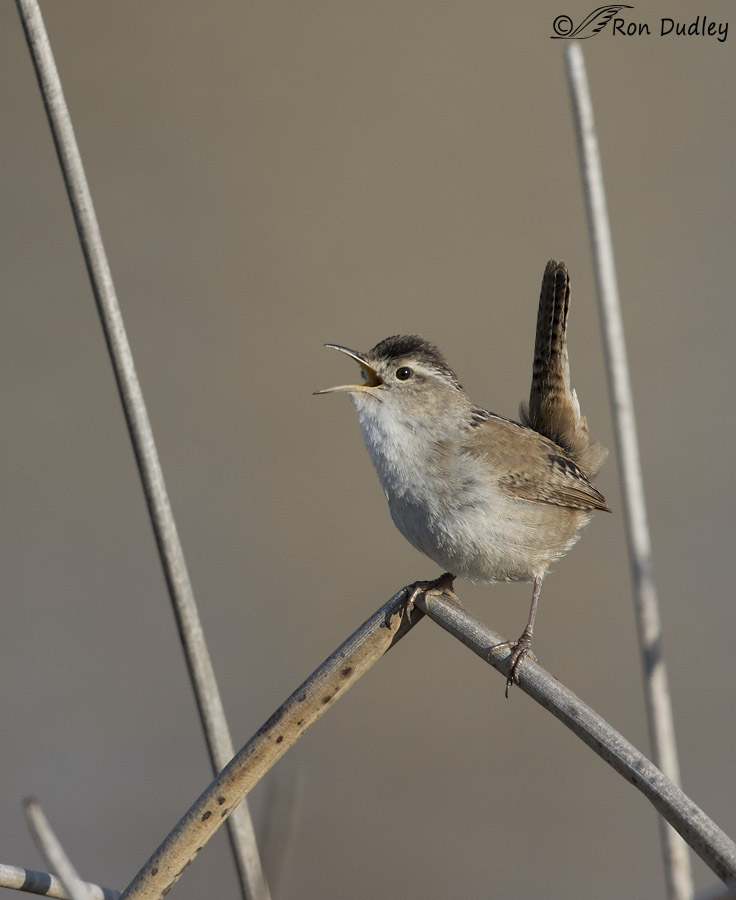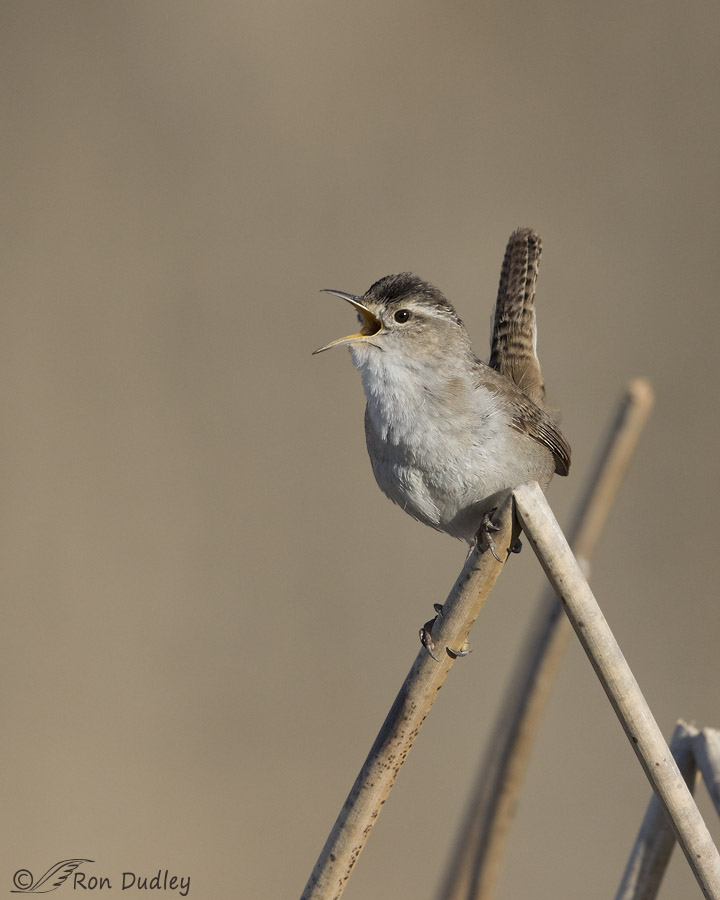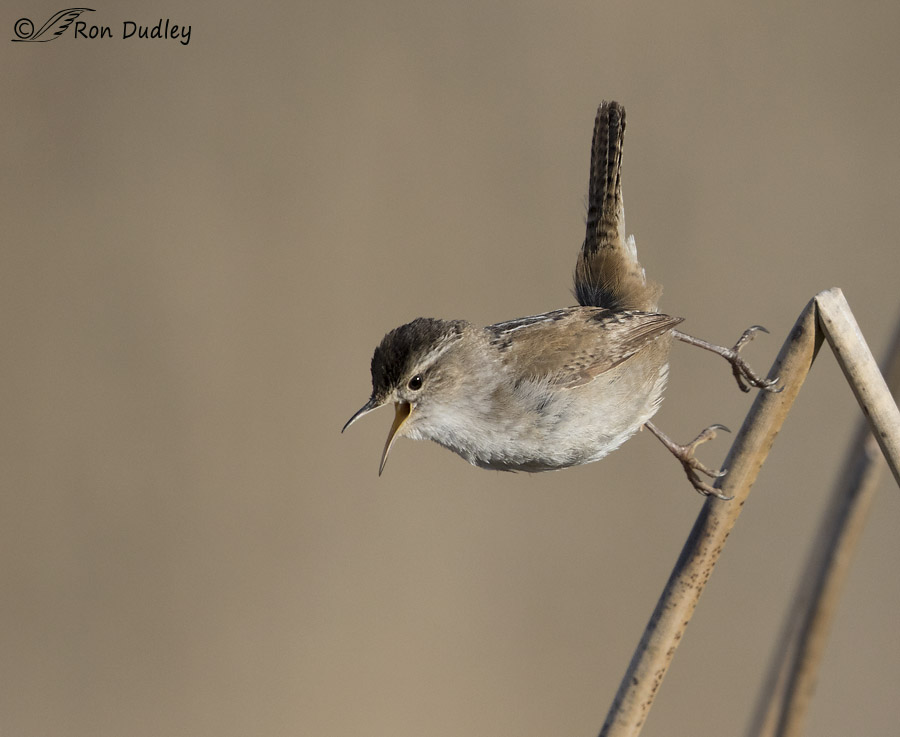The Marsh Wren is an inveterate singer, consequently every one of these wrens has its mouth open. I photographed each one (several are the same bird) two days ago at Bear River MBR.

1/3200, f/7.1, ISO 800, Canon 7D Mark II, Canon EF500mm f/4L IS II USM +1.4 tc, not baited, set up or called in
My photos of the species often include a busy setting like this one. I can be ok with that because I like to include typical habitat in my images but it can get a little messy so…

1/4000, f/6.3, ISO 800, Canon 7D Mark II, Canon EF500mm f/4L IS II USM +1.4 tc, not baited, set up or called in
I also appreciate the occasional image where I catch the bird against a reasonably clean background. I like the way this one is framed by vegetation though I do wish the vertical stem at right was more in focus and wasn’t quite so close to the bird.

1/4000, f/7.1, ISO 800, Canon 7D Mark II, Canon EF500mm f/4L IS II USM +1.4 tc, not baited, set up or called in
I was up to my old tricks in this series of shots by using very high shutter speeds but these little dynamos are about as quick as birds get and one of my goals was to catch one of them in flight. I came very close to succeeding…
 1/4000, f/7.1, ISO 800, Canon 7D Mark II, Canon EF500mm f/4L IS II USM +1.4 tc, not baited, set up or called in
1/4000, f/7.1, ISO 800, Canon 7D Mark II, Canon EF500mm f/4L IS II USM +1.4 tc, not baited, set up or called in
when this one launched toward another perch at stage left. Both feet have left the perch but its wings are still folded against its body. I like the fact that it just couldn’t resist continuing to sing as it took off.
I meant it when I referred to Marsh Wrens as “inveterate singers”. Though most folks don’t much appreciate their melodic qualities (Audubon compared their song to the “grating of a rusty hinge”) they are ranked among North America’s most impressive songsters. Young males learn up to 200 different song types and they tend to sing all day long. Midnight concerts are held regularly throughout most of the summer.
Other birds must think of them as noisy neighbors indeed.
Ron


These wrens are definitely “eye candy”…as long as I have some earphones to turn off whenever I get over saturated with the repetition of their singing…
Great shots!
Fantastic shots of a very elusive bird Ron!
Charlotte
Thank you, Charlotte.
Superb songster series,sir!
We only see them during migration and it’s wonderful to walk along a path in the marsh with a couple dozen little voices sampling those couple hundred vocalizations you mentioned! And that’s when they’re NOT breeding! Can’t imagine what you’re hearing.
“Can’t imagine what you’re hearing.”
It’s a cacophony, Wally. It truly is.
My hypocritical self likes birds wot can’t keep their mouths shut soooo much more than people.
Great series, and are you sure that the final bird actually flew? If so, he/she IS able to walk and chew gum rather better than a lot of people.
“are you sure that the final bird actually flew?”
Actually I’m not, EC. It landed just a short distance in front and below its position in the photo so who knows? Not me…
I think all wrens are famous for their loud voices. I know we are always listening to Canyon Wrens at Hueco Tanks; they know how to enhance their voices by using the rocks’ acoustic properties. They have a beautiful song. These little Marsh Wrens are cute, and even if their song isn’t considered the most pleasant by some, I would probably enjoy listening to them simply because I love how big their voices are in comparison to the size of the bird. I love the last picture, where the feet have left the branch. I hope he didn’t forget to open his wings…
Hueco Tanks must be quite a place, Susan. I’ve “heard” you talk about it for so long that I almost think I know it…
Ron, it really is quite a place. As a matter of fact, the park is in the process of applying for UNESCO world heritage site status. Or someone is on behalf of the park. It is an oasis in the desert with relictual species of plants from the last ice age, a huge number of pictographs, the largest collection in North America of mask paintings (from the Jornada Mogollon people), archeology everywhere, and, since we’re on the south end of the Rocky Mountain flyway, we get about 250 species of birds (we had our second sighting in 3 years of a male Belted Kingfisher last week, to give you an example). If you would like to check out our blog, the first section of it is about the park. I’ve tried to identify everything I see there that is living, and post it there. Given the number of new flowers I’ve encountered this spring alone, it is clearly a work in progress. The url is http://www.rovingstones.com. (The bird section is necessarily very sparse, because I am NOT a bird photographer…)
The last shot is obviously in preparation for the dying diva shot in Carmen!
Obviously!
Remarkable! I have attempted shooting these many times and rarely have captured anything satisfying. They are tiny, aware and very active targets.
“They are tiny, aware and very active targets.”
That’s them in a nutshell, Dan.
I often think of wrens as the Jack Russell terriers of the bird world…
Good comparison, Patty.
A wonderful, funny series…I wonder when (and IF!) these sassy little loud mouths ever have time to eat!!! It seems most wrens are non- stop singers…to the point ,at least with House Wrens, I have serious thoughts of birdicide. The last frame made me laugh because its feet position and wide open mouth make it look like it sang itself tight off of its perch!!!
Thank you, Patty.
I love Marsh Wrens. When I saw the pictures I laughed out loud — they are so tiny, but always making a lot of noise!
Christina, they’re so loud for their size that sometimes I think those little bodies must be all larynx (or in this case, syrinx…)
I love Marsh Wrens and these are wonderful images. J. Fenwick Lansdowne’s painting of the Long-billed Marsh Wren is one of my very favorite watercolors and I’ve dreamed about capturing an image like any one of the ones in your post. I like both the “messy” background and the tidier one equally in this case. I love the third image because the bird doesn’t have his wings open. It really shows how they throw themselves off of their perches. I know what you mean about songsters. More often than not (unless it’s dating season) I can hear a chorus of songs as I pass reed clumps and never see one of these little guys. Thanks so much for a morning of wrens!
You sound like a real fan of Marsh Wrens, Sharon. I concur.
Ditto Dick Harlow’s comment. Terrific series of a bird difficult to get in the open.
Thank you, Dave.
The last shot looks like he is trying to hit the ‘high’ note!!!
He does look like he’s straining a bit, doesn’t he, Ellen?
WOW! was my first impression of these shots! Fantastic, close, clear, sharp, wonderful shots of a small bird, although quite a songster. Many thanks!
Thanks very much, Dick.
Those are great shots! I’ve never gotten such clean shots of this bird; they’re always deep in the reeds. But I’m going out in an hour or so to set up my tripod by a marsh wren nest. Wish me luck!
Luck sent your way, Mark. Lots of it!